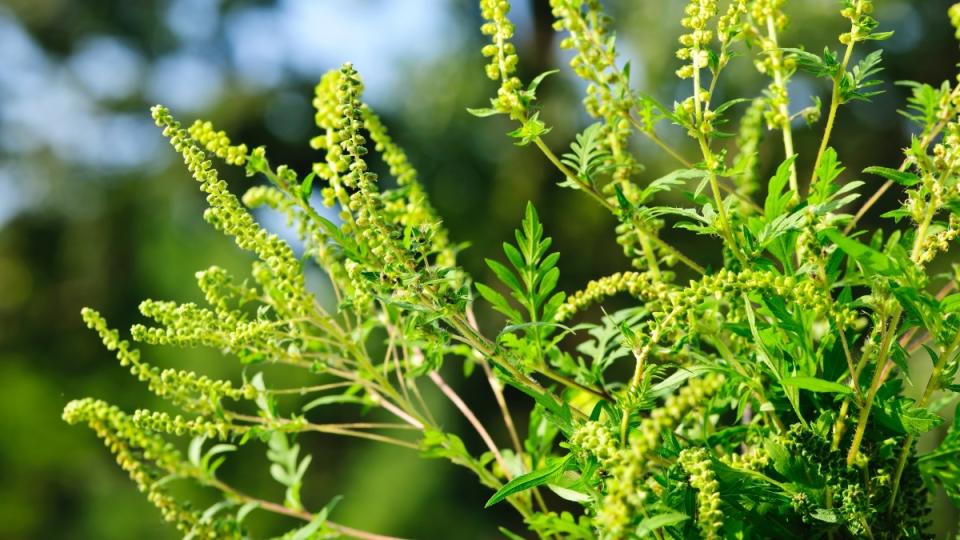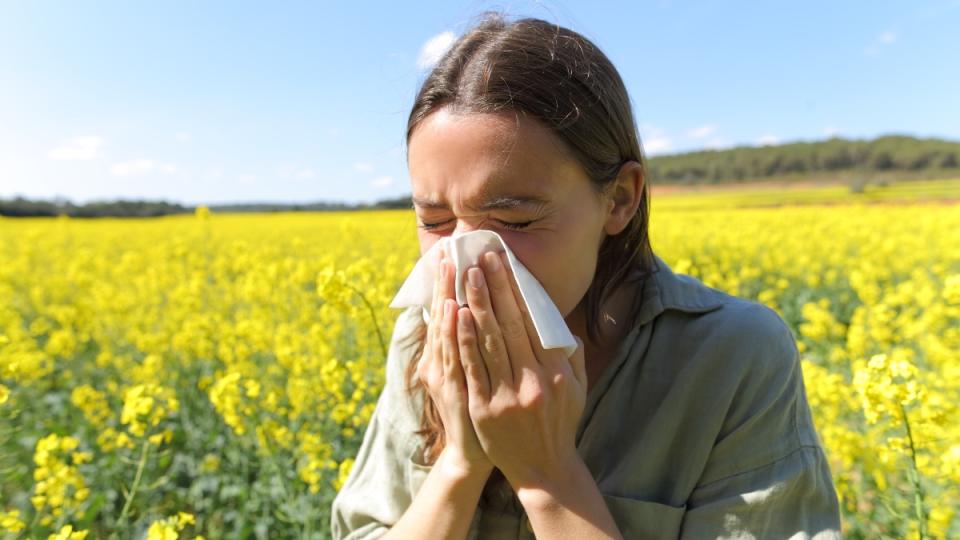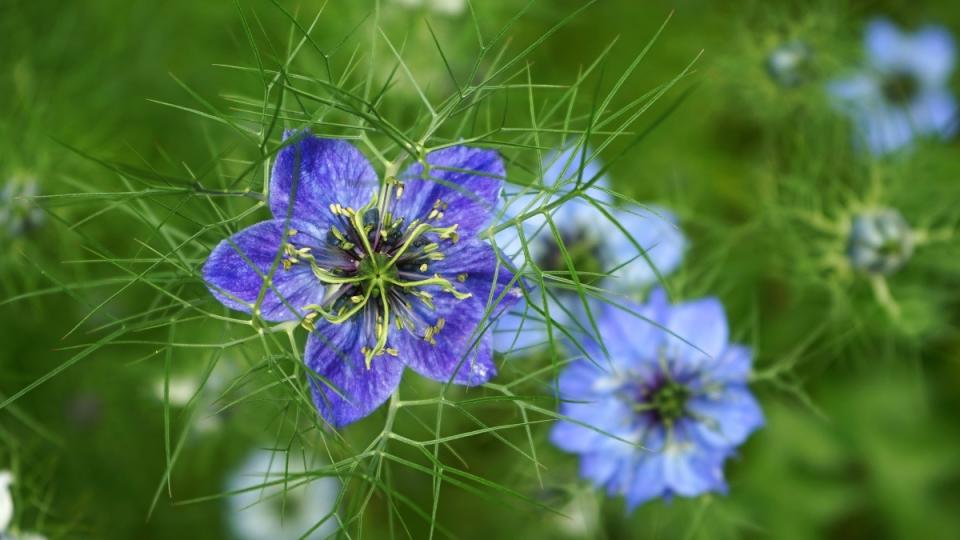Natural Ragweed Allergy Remedies Deliver Relief in as Little as 5 Minutes, MDs Say — Without the Side Effects of OTC Meds
We love fall's crisp air, the colorful leaves and the return of pumpkin spice lattes. But we could do without the sniffling and sneezing the change of seasons brings. The cause of the discomfort? Ragweed pollen, a troublemaking allergen that can trigger everything from sinus congestion to itchy eyes to headaches. Luckily, you don't need to trek to the drugstore to tamp down symptoms. We've rounded up the best home cures that deliver powerful natural ragweed allergy relief.
What is a ragweed allergy?
You may have heard the terms ragweed allergy and hay fever used interchangeably. But technically, they're not the same thing. Hay fever is another name for allergic rhinitis, an umbrella term that refers to inflammation in the nose caused by various types of allergens. Ragweed is the most common allergen that triggers hay fever.
Understanding what causes hay fever
Hay fever is relatively common, affecting 30% to 40% of the population to some degree, says asthma, allergy, and immunology specialist Jill Poole, MD, a professor and chief of the allergy and immunology division at the University of Nebraska Medical Center in Omaha.
Hay fever affects some people year-round, being triggered by indoor allergens such as mold, dust mites, pet dander, smoke or even perfume. But for others, hay fever only flares up during spring and fall when there's an uptick in pollen from trees, grass and weeds (including ragweed). And sometimes it can strike for the first time later in life.
Understanding what causes a ragweed allergy
Ragweed is far and away the most common cause of fall allergies in 2023. In fact, pollen released from the ragweed plant affects almost 50 million people in the US, according to the Asthma and Allergy Foundation of America (AAFA).
Ragweed is a tall, flowery plant that’s part of the Asteraceae or aster family, the same one that includes sunflowers, daisies, and dandelions. The ragweed plant grows in almost all U.S. states as well as Canada, but it's most concentrated in the Eastern and Midwestern states. It generally grows more in rural areas, but can also be found in suburbs and cities, too.
“Ragweed season typically begins in mid-August, peaks around Labor Day, and ends by a hard freeze, usually sometime in October,” says Dr. Poole. However, the AAFA notes ragweed allergies can start as early as July and last well into November. During these months, one single plant can produce up to 1 billion pollen grains. And these bits of pollen can travel hundreds of miles through the air, getting into your nose, eyes, and lungs where they cause irritation and inflammation.

Are fall allergies worse in 2023?
If feel like your fall allergies have ramped up in 2023, it’s not your imagination. A report found warmer temperatures and less freeze-free days the past few years have increased pollen production, making allergy season longer and more intense. In fact, researchers found that across the US, the freeze-free season lengthened on average by 15 days. This gives plants including ragweed more time to grow, flower and release troublemaking pollen.
Common symptoms of a ragweed allergy
If you’re allergic to ragweed, your symptoms most likely include nasal congestion, sneezing, a runny or stuffy nose, irritated eyes, an itchy throat, and headaches, according to the American College of Allergy, Asthma, & Immunology (ACAAI). Symptoms can range in intensity from mild to severe.
Other ragweed allergy symptoms include post-nasal drip, nose bleeds, snoring, mouth breathing, and dark circles under your eyes, notes Joyce Yu, MD, an allergist and an associate professor of pediatrics at the Columbia University Irving Medical Center in New York City. “You may also feel a fullness and pressure in the sinuses, sinus headaches, ear popping, and a loss of smell,” adds Dr. Yu. Loss of smell can be attributed to plugged up sinuses, altered air flow, or inflammation affecting the function of the smell receptors in the nose, Dr Yu explains.
People most likely to suffer from a ragweed allergy
You may be more likely to be allergic to ragweed if you’re also susceptible to other hay fever offenders such as dust mites, mold, and pet dander. “The more you are allergic to one thing, the more likely you are to be allergic to another,” explains Christopher Brooks, MD, an allergist and immunologist at The Ohio State University Wexner Medical Center in Columbus, Ohio. “This is even more true among pollens, where if you are allergic to weed pollens like ragweed pollen, you are more likely to be allergic to tree pollen and grass pollen.”
Another risk factor for ragweed allergies: genetics. Researchers at the Allergy & Asthma Network found if you have one parent with allergies, you’re 50% more likely to have allergies, too. And if both parents have allergies, the likelihood goes up to 75%. What's more, a study in the International Journal of Environmental Research and Public Health found folks who have a parent with an allergic disease have an increased risk of ragweed sensitization.

When you should see a doctor for ragweed allergy relief
Home remedies can provide powerful natural ragweed allergy relief. But if your symptoms are still flaring up despite trying natural fixes, it might be time to schedule a visit with your doctor. “If your allergies are causing symptoms such as chronic sinus infections, nasal congestion or difficulty breathing that are interfering with your sleep, school or work productivity, or quality of life, you’ll want to see an allergist,” says Dr. Poole.
An allergist may prescribe a stronger antihistamine or a nasal steroid spray. For more severe allergies, your doctor may also suggest immunotherapy treatments, available as allergy shots or dissolvable sublingual tablets you put under your tongue.
Allergy tablets treat one type of allergen, while injections can provide relief from more than one. So if you suffer from ragweed allergies in the fall but also from dust mites year-round, an allergy shot is often a better bet. Allergy shots are especially effective for stubborn cases of hay fever. According to the ACAAI, these treatments help reduce symptoms of hay fever in about 85% of people who have it.
8 natural ragweed allergy relief remedies
While allergy shots and prescription medications can help in severe cases, they can sometimes cause bothersome side effects such as a daytime sleepiness, stuffy nose, itching, sneezing or hives. What's more, they often take at least 6 months (sometimes up to a year) before they start providing real relief. If you'd rather start with fast-acting and side effect-free natural ragweed allergy remedies, these are best ways to find relief:
1. A neti pot delivers natural ragweed allergy relief
A neti pot resembles a small tea pot with a longer spout that you insert into one nostril to flush allergens out the other nostril. “When you’re using a neti pot, you’re basically flooding your nose and sinuses to help wash out mucus and allergens so it decreases long-term inflammatory response,” explains Dr. Brooks, who is also an assistant professor of allergy and immunology at the The Ohio State University College of Medicine.
“It’s a very safe and natural thing to do. I often recommend patients start out by doing it once per day for about three weeks to see if it works. They can increase to twice per day or decrease to an as needed basis. It’s whatever works best for controlling their symptoms.” It's so effective, a study in the journal American Family Physician found it reduces symptoms by 64% almost instantly. For a quick how-to, check out the video below.
Dr. Brooks says you can also use a nasal rinse to irrigate your passages. While leaning over a sink, insert the tip of the spray bottle into one nostril and squeeze the rinse into your nose. Repeat with the other nostril, then blow your nose to further flush out allergens. A nasal rinse he suggests and uses himself for his seasonal allergies: NeilMed Sinus Rinse (Buy from Walmart, $11.48) "Their products have been around a long time and my patients have told me they’ve helped their allergy symptoms a lot.”
Dr. Christopher Brooks' nasal rinse recipe
If you'd prefer to make your own sinus rinse at home, here’s a simple DIY recipe from Dr. Brooks:
? teaspoon salt
? teaspoon of baking soda
8 oz. of distilled water or boiled (and cooled) tap or bottled water
Mix the salt, baking soda, and water together in a nasal spray bottle or bulb syringe bottle. Spray mixture into each nostril while leaning over the sink to whisk away ragweed allergens.
Note: “It’s very important to use distilled or boiled tap water, because tap water isn’t always clean,” says Dr. Brooks. Bacteria found in tap water systems can cause an infection in your nasal cavity or sinuses, and contaminated water could pose serious health risk if it gets too close to your brain. Just make sure the water has cooled to room temperature before using.
2. A steamy shower delivers natural ragweed allergy relief
When ragweed allergy symptoms flare up, relaxing in a hot shower can provide soothing natural relief. Breathing deeply during steamy shower cleans out pollen from nasal and upper airway passages, making it easier to breathe, says Dr. Yu. “Inhaling steam can also keep passages moist, loosen up mucus and ease irritation,” she adds.
A study in the Asian Pacific Journal of Allergy and Immunology found people with hay fever who inhaled steam for just five minutes significantly increased their total nasal air flow, and the improvement in their symptoms lasted more than 7 hours. For best benefits, Dr. Yu suggests inhaling steam for about 10 to 15 minutes.
Tip: When possible, take a steamy shower at the end of the day. Why? It helps wash away any allergens that have accumulated on your hair, eyelashes, and skin, says Dr. Yu. (For added allergy relief, click through to see the best bedding for allergies.)
3. Onions deliver natural ragweed allergy relief
Noshing on apples, blueberries, broccoli, tomatoes, nuts, seeds, and onions can all help keep ragweed allergy symptoms at bay. These foods are packed with a unique flavonoid known as quercetin. This potent antioxidant is known for its anti-inflammatory and anti-histamine benefits.
A study in the European Review for Medical and Pharmacological Sciences found supplementing with 200 mg. or quercetin daily reduces symptoms like sneezing, runny nose and eye irritation by 50%. Bonus: Folks who took quercetin also slept better and felt up to twice as energized and upbeat. One to try: Emerald Labs Quercetin Phytosome 250 mg. (Buy from Amazon.com, $34.16)
If you prefer food fixes, you'll get the best bang for your buck with onions. A study in Food & Function found consuming a bowl of soup make from red onions lifts quercetin levels as much as a 544 mg. quercetin supplement can! (Click through to discover the health benefits of onion skins.)

4. Ginger delivers natural ragweed allergy relief
Ginger has been used as a healing remedy for thousands of years to treat conditions like nausea, an upset stomach, the common cold, and arthritis, to name a few. But this popular spice is also one of the best natural remedies for ragweed allergies. Research in BMC Complementary Medicine and Therapies found taking 500 mg. of ginger extract relieves nasal congestion as well the antihistamine loratadine (Claritin). The researchers credit ginger’s natural anti-inflammatory properties with decreasing stuffiness and opening up the nasal cavity.
You can get your ginger fix in supplement form or by using the spice in cooking, ginger shots or ginger tea. If you're brewing up a cuppa, add a squeeze of honey to boost the benefits. “My patients have taken honey in their tea to potentially symptomatically feel better,” says Dr. Yu. “It provides a soothing sensation by coating a dry throat like a cough drop." (Click through to learn about the benefits of ginger shots.)
5. Black seed oil delivers natural ragweed allergy relief
Ginger isn't the only herbal remedy for ragweed allergies — a compound known as black seed oil can help, too. Black seed oil is extracted from the Nigella sativa plant, a pretty flowering plant also called black cumin. A study in Anti-Inflammatory & Anti-Allergy Agents in Medicinal Chemistry suggests 92% of people who took black seed oil daily saw an improvement in their hay fever symptoms within 6 weeks. And 69% of them become symptom-free! One to try: Prime Natural Organic Black Seed Oil (Buy from Amazon.com, $16.49).

6. A face massage delivers natural ragweed allergy relief
The secret to clearing nasal congestion triggered by ragweed allergies is at your fingertips — literally! Stimulating an acupressure point on your face known as LI 20 signals sinuses to release trapped fluids that cause pressure and congestion. And simply rubbing this area when your sinuses are clogged reduces stuffiness and pressure by 56% in as little as 60 seconds, suggests research in the Journal of Alternative and Complementary Medicine.
To do: Place your index fingers beside the edge of each nostril, right at the spot where the nose and face meet. Relax your face, then massage in gentle circles for 60 seconds. Repeat twice daily, or as needed. For a quick how-to, check out the video below.
7. Butterbur delivers natural ragweed allergy relief
While you may be inclined to reach for an OTC allergy pill like Zyrtec for lasting ragweed allergy relief, they can trigger unwanted bothers like daytime fatigue, nighttime restlessness and other pesky side effects. A better option: Butterbur. A study in the British Medical Journal found the compound petasin in the flowering plant is more effective and better tolerated than the OTC drug. Aim for 75. mg of butterbur twice daily to feel relief within 5 days. One to try: Nature's Way Petadolex Pro-Active Butterbur (Buy from Amazon.com, $36.06).
Note: Don’t take if you have a history of liver disease and always choose butterbur labeled "free of pyrrolizidine alkaloids," which are toxic to the liver.
8. Air purifiers deliver natural ragweed allergy relief
You may not be able to control the ragweed pollen outside, but you can tamp down the allergen indoors to keep it from triggering symptoms. One option: Using an air purifier with a high-efficiency particulate air (HEPA) filter in a room where you spend a lot of time, such as your living room or bedroom. Experts at the U.S. Environmental and Protection Agency (EPA) say a HEPA filter can remove at least 99.97% of pollen, dust, mold, bacteria, and other potentially harmful particles. Plus, a study in the Yonsei Medical Journal found when people with hay fever used a HEPA air purifier for 6 weeks, they reduced their need to take allergy medicine by 26%.
And as tempting as it might be to throw open the windows for fresh air, skip it if you can. You’ll want to keep your windows closed during pollen season, especially in the morning when pollen counts are the highest, says Dr. Brooks. Not sure how much pollen is in the air where you live? You can check the local pollen count through The American Academy of Allergy, Asthma and Immunology’s National Allergy Bureau.
For more ways to outsmart allergies:
4 Common ‘Hidden’ Allergies, And a Few Effortless Ways to Remedy Them
